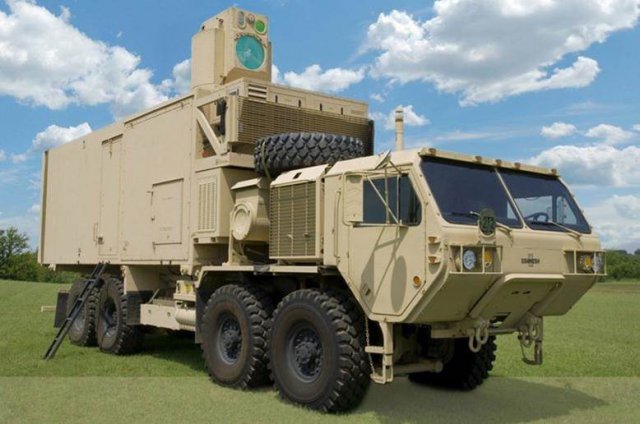The U.S. Army Space and Missile Defense Command/Army Forces Strategic Command for the first time used a vehicle mounted high energy laser to successfully engage more than 90 mortar rounds and several unmanned aircraft systems in flight.
This occurred during multiple test events of the Army High Energy Laser Mobile Demonstrator conducted between Nov. 18 and Dec. 10 at the High Energy Laser Systems Test Facility, White Sands Missile Range, N.M.
This was the first full-up demonstration of the HEL MD in the configuration that included the laser and beam director mounted in the vehicle. A surrogate radar (Enhanced Multi Mode Radar) supported the engagement by queuing the laser.
The HEL MD is being developed to show directed energy force protection capabilities against rockets, artillery, mortars, unmanned aircraft systems and cruise missiles. The HEL MD programme is managed by SMDC’s Technical Center.
Mortars travel at low velocities for short ranges in high-arching trajectories. These weapons as well as UAS, are representative of the threat encountered by U.S. and allied forces on the battlefield.
Initial system effectiveness was proven through low and medium power test demonstration that took place in 2011. High power testing is now concluded at HELSTF. The demonstration and testing confirms the capability of a mobile solid state laser weapon system to counter mortars, UAS, and intelligence, surveillance and reconnaissance sensors mounted on the UAS.
The recent testing utilized a 10 kW class laser. In the future, a 50 kW class laser will be integrated into the HEL MD platform. The 50 kW laser is scheduled to be upgraded to a 100 kW class laser in subsequent demonstrations. The supporting thermal and power subsystems will be also upgraded to support the increasingly powerful solid state lasers. These upgrades increase the effective range of the laser or decrease required lase time on target.
 The beam control system (BCS) is a dome-shaped turret that extends above the roof of a 500-horsepower Heavy Expanded Mobility Tactical Truck (HEMTT). The beam director rotates 360-degrees and uses mirrors to point and focus the quarter-sized beam on a target.
The beam control system (BCS) is a dome-shaped turret that extends above the roof of a 500-horsepower Heavy Expanded Mobility Tactical Truck (HEMTT). The beam director rotates 360-degrees and uses mirrors to point and focus the quarter-sized beam on a target.
The laser beam moves at approximately 186,000 miles per second, the speed of light, and hits targets with unprecedented precision.
“These tests were the first in which HEL MD repeatedly destroyed consecutive rounds of mortars and aerial threats with speed-of-light precision and a high degree of accuracy,” Mike Rinn, Vice-President, Boeing Directed Energy Systems.
This joint project is entering its seventh year with a 2013 fiscal year budget of a staggering $12.4 million.
“The system is being validated by the United States Army and they will determine when its ready for the battlefield,” wrote Dexter Henson of Boeing’s Strategic Missile & Defense Systems.
“We had considerable success,” says Terry Bauer, Army Programme Manager for the High Energy Laser Mobile Demonstrator.
The circumference of the laser beam is about the size of a quarter. When it is directed at a 60-millimeter mortar, it heats the mechanisms inside the mortar and forces them to blow out of the sides in a low-level midair explosion.
“It falls as a single piece of metal with a little bit of shrapnel. It basically falls where it was going to fall, but it doesn’t explode when it hits the ground,” Mr. Bauer says. “We turn it into a rock, basically.”
In the case of the UAS, Army testers were initially interested in the laser’s ability to blind the sensors on the UAS, which are equipped with cameras. After those efforts were successful, testers then used the laser to damage a UAS tail, “and that brought it down,” Bauer adds.
In an era of belt-tightening around the Pentagon, the laser weapons are also cheap to operate, say Army officials, who estimate that the “cost per shot” is about a cup of diesel fuel.
That is tactically useful because the laser weapon is a “serial killer,” Bauer says – meaning that it can shoot only one target at a time, not multiple targets at once, so faster is better.
For now, the Army will take the weapon system down to Florida’s Gulf Coast early next year, says Bauer, “to test it in rain and fog and things like that.”
The Boeing Company is the prime contractor for the HEL MD programme.
Photos: Top – U.S. Army Space and Missile Defense Command; Centre -Eric Shindelbower/Boeing
Sources: Christian Science Monitor; US Army; Business Insider

